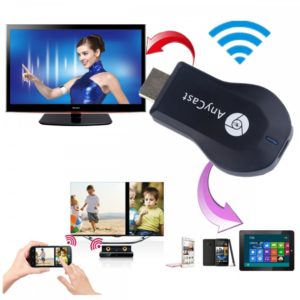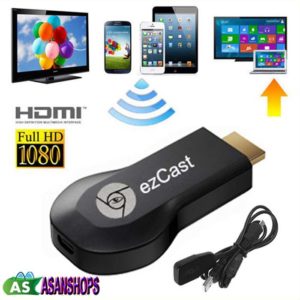…
Thu, July 17, 2025
If you’re considering finally abandoning those clunky cables at your corporation in trade for a wireless solution, a number of options out there ca...…
 If you’re considering finally abandoning those clunky cables at your corporation in trade for a wireless solution, a number of options out there can be unbelievable. Since we know a thing or two about streaming wirelessly with HDMI, we want to assist you to get a survey of the different clarifications out there. To do so, we intend to be as objective as practicable. Wireless alternatives to HDMI cables Streaming Wireless with HDMI is a funky term for the broadcast of (high definition quality) video and audio from a source device to a TV screen or projector without any cable or wired support. This technology is the replacement of conventional VGA and HDMI cables. HDMI is the current cabled standard with most TVs and monitors coming installed with multiple HDMI ports. There are numerous existing cableless HDMI solutions, which can leave you disoriented as to which one is best for your needs - but typically you can separate them into two categories. Solutions that use a transmitter for communications and those that use apps. Wireless HDMI transmitter vs apps
If you’re considering finally abandoning those clunky cables at your corporation in trade for a wireless solution, a number of options out there can be unbelievable. Since we know a thing or two about streaming wirelessly with HDMI, we want to assist you to get a survey of the different clarifications out there. To do so, we intend to be as objective as practicable. Wireless alternatives to HDMI cables Streaming Wireless with HDMI is a funky term for the broadcast of (high definition quality) video and audio from a source device to a TV screen or projector without any cable or wired support. This technology is the replacement of conventional VGA and HDMI cables. HDMI is the current cabled standard with most TVs and monitors coming installed with multiple HDMI ports. There are numerous existing cableless HDMI solutions, which can leave you disoriented as to which one is best for your needs - but typically you can separate them into two categories. Solutions that use a transmitter for communications and those that use apps. Wireless HDMI transmitter vs apps  Wireless transmitters for HDMI Many solutions require both an HDMI transmitter and receiver for transferring and streaming data. A wireless transmitter for HDMI is a device that is plugged into the source device, i.e., your computer. The transmitter registers the computer screen and sends it to a recipient by some type of radio connection. Pros: It utilizes its own wireless frequency and consequently often a good and stable streaming quality. Cons: You need to ram a USB or HDMI stick into your computer. This rules out mobile or tablet use straightaway. And if you don’t have a compatible HDMI port on your computer, you will need an adapter and converter, as is the case with a normal HDMI cable. Wireless choices to HDMI using apps Other solutions use software to collect and send data from the source device to the TV screen or projector. Instead of ramming a device into your computer, you download an application. Pros: You don’t need to plug anything into the device you want to share from. You just use an app and a WiFi connection. Cons: Relies on the WiFi connection, so if you are in a workplace with a bad WiFi connection, your streaming will consequently be bad. (Note: Internet connection and WiFi connection are not the same things) Why use HDMI wirelessly? Well, who would use wires if you can make it wireless? It is comparatively much easier and convenient to get off the tangling situations where the cables and wires just get stuck here and there and most of the time, you are just trying to untangle them. Streaming HDMI is essential when a wired connection would be too clunky or inconvenient. It’s surely better than having to install cables 'neath the floor or in the walls of an office or creating DIY solutions that involve zip ties and duct tape to run the cables along the floor. If you can do something about those cables, then all you can do is to change them with HDMI Wireless dongles that are way much more helpful. And as they are categorized in 2 categories listing their pros and cons; it makes you much strengthened to distinguish between the one you need to buy and the one you need not to. There are no certain recommendations from Laptab regarding which HDMI dongle would be more suitable for you as it more depends on the buyer needs than our instructions itself. HDMI WiFi dongles usually run on a radio frequency of 2.4 GHz. Furthermore, a working distance of at least 30feet is good. Laptab hopes that we were able to satisfy you for buying the best Wireless dongle for you.
Wireless transmitters for HDMI Many solutions require both an HDMI transmitter and receiver for transferring and streaming data. A wireless transmitter for HDMI is a device that is plugged into the source device, i.e., your computer. The transmitter registers the computer screen and sends it to a recipient by some type of radio connection. Pros: It utilizes its own wireless frequency and consequently often a good and stable streaming quality. Cons: You need to ram a USB or HDMI stick into your computer. This rules out mobile or tablet use straightaway. And if you don’t have a compatible HDMI port on your computer, you will need an adapter and converter, as is the case with a normal HDMI cable. Wireless choices to HDMI using apps Other solutions use software to collect and send data from the source device to the TV screen or projector. Instead of ramming a device into your computer, you download an application. Pros: You don’t need to plug anything into the device you want to share from. You just use an app and a WiFi connection. Cons: Relies on the WiFi connection, so if you are in a workplace with a bad WiFi connection, your streaming will consequently be bad. (Note: Internet connection and WiFi connection are not the same things) Why use HDMI wirelessly? Well, who would use wires if you can make it wireless? It is comparatively much easier and convenient to get off the tangling situations where the cables and wires just get stuck here and there and most of the time, you are just trying to untangle them. Streaming HDMI is essential when a wired connection would be too clunky or inconvenient. It’s surely better than having to install cables 'neath the floor or in the walls of an office or creating DIY solutions that involve zip ties and duct tape to run the cables along the floor. If you can do something about those cables, then all you can do is to change them with HDMI Wireless dongles that are way much more helpful. And as they are categorized in 2 categories listing their pros and cons; it makes you much strengthened to distinguish between the one you need to buy and the one you need not to. There are no certain recommendations from Laptab regarding which HDMI dongle would be more suitable for you as it more depends on the buyer needs than our instructions itself. HDMI WiFi dongles usually run on a radio frequency of 2.4 GHz. Furthermore, a working distance of at least 30feet is good. Laptab hopes that we were able to satisfy you for buying the best Wireless dongle for you.